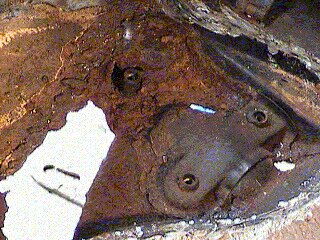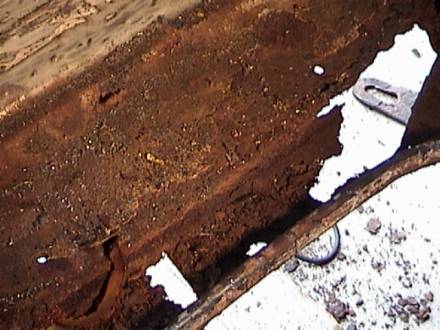Porsche
Front Suspension Pan
When I first noticed a couple of small holes in the front pan (after I bought the car) I had no idea how extensive it was.
I started poking with a screwdriver and before I knew what was happening most of my front pan was laying on the driveway in big brown flakes. I was amazed that the front suspension had not completely fallen apart while I was driving.
The front pan problem is apparently fairly common but extensive searching on the internet only turned up a few sites with information about fixing it.
The best site I found was Jamie Novak's description of the restoration of his 1971.
Inspired by Jamie and few other sources (and feeling guilty that I bought the car without checking for rust) I decided to tackle the repair myself. First the gas tank support had to be removed by drilling a couple of dozen spot welds. Once this was removed I could really see how bad the problem was:
Typical rusting for this vintage car!
It was a lot of work but I finally got the old pan out:
This is the car just before welding in the new parts. I have the new replacement pan and gas tank support but I still
need to do some clean-up with the grinder before welding it in. The new pan from Restoration Design is a very good quality
part but don't forget to ask for the reinforcing braces that go on the top side because they tend to forget to tell you about it.
Here are the final results on the welding with a coat of primer on to prevent more rust.
After this it got a heavy coat of paint top and bottom of the effected area and then a good layer of tarry plastic undercoating.
At this point the car is back on the road and I have done two autocrosses with it since the rust repairs.
I took it to a shop specializing in German imports to get a professional alignment
and had turbo tie rods put on at the same time.
Notes:
I did the work with a B&D drill, a Skill side grinder and a Dremel Tool. I really needed a die grinder instead of the
Dremel Tool. I probably could have done everything with the die grinder instead of the side grinder. At least half of the
spot welds can be drilled to break them loose. I used a 5/16" high strength drill specifically made for steel to drill
through one (the one I was removing) sheet of metal not both. There were some spots that I just could not
get to with either the drill or the side grinder so I used a 1.25" fiber reinforced cut-off wheel
on the Dremel Tool to cut through a significant portion of metal. I wore out about six of those
wheels cutting through sheet steel.

